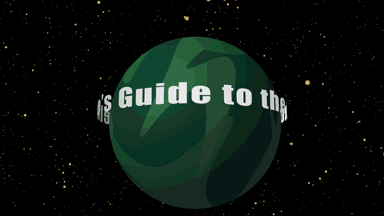Scienceline’s Guide to the Exoplanets: The Infernal Pebble
CoRoT-7b: The first rocky planet discovered...after a fashion
Rahul Rao • August 24, 2020

Your favorite planets, and you didn't even know they existed. [Credit: Curtis Segarra | CC BY-NC-ND 2.0]
The Infernal Pebble
CoRoT-7b
Discovered by: CoRoT
Discovered: 2009
Distance from Earth: ~490 light-years
Radius: ~1.6 Earth radii
Surface climate: Like molten ice cream, only hotter
Habitability for humans: No.
When CoRoT-7b was discovered in 2009, it was the first solid, terrestrial exoplanet ever found. Looking back from 2020, from a time after Kepler, it does feel strange to think that it’s only been little over a decade since then. But, in 2009, CoRoT-7b was a landmark in exoplanet science, proving what astronomers had spent so much time looking for: an exoplanet with “a surface to walk on.”
But space is big, and if you were expecting CoRoT-7b to be anything like Earth, you’d be wrong.
For one, even though CoRoT-7b is rocky and solid — and not much larger than Earth — it’s quite a bit more massive. Astronomers aren’t quite sure how massive. Since CoRoT-7b, like so many other exoplanets, was discovered by observing the change in light caused by passing in front of its star, astronomers know its radius, but not its mass.
Various estimates since then have given wildly ranging figures, from 3 to 8 Earth masses. That makes it denser than the Earth, and scientists think that its interior is something like Mercury, largely consisting of iron.
Some scientists even think that CoRoT-7b might be the core of a gas planet whose outer layers have long been stripped away, though others counter that the system is quite young, and that this is unlikely.
In any event, CoRoT-7b’s mass places it solidly in the category of super-Earths, and a very large super-Earth at that.
Of course, there’s another thing that makes CoRoT-7b different from Earth: its surface is searing hot.
CoRoT-7b’s star is yellow, fairly Sun-like, if slightly smaller and slightly less luminous. But CoRoT-7b orbits its star at a distance that’s about one twenty-third that of the Sun and Mercury. It completes a full orbit in around twenty Earth hours; and in one Earth month, nearly forty years will have passed on CoRoT-7b.
As you’d probably guess by now, if you were expecting a surface to walk on, then you probably won’t find it here. CoRoT-7b’s surface is, on average, three times hotter than Mercury.
Astronomers believe that the planet is tidally locked, with one side in eternal oppressive daylight, perpetually facing its star. With the rocks on the daylit side perpetually basking in light, it’s likely that they’re entirely molten. Like another planet we’ve seen in this space before, large parts of CoRoT-7b’s surface may be covered by an ocean of lava.
The nightside would be cooler. But even if it were terra firma, dry land, then there would be another problem: the star’s gravity would violently toy with the planet’s interior. The result would be something like Jupiter’s moon Io: constant volcanic eruptions blasting pools of lava onto the surface.
So not only would you be dealing with oppressive heat, you’d be dealing with a crust being constantly torn apart. But remember, this was the first terrestrial exoplanet we found.